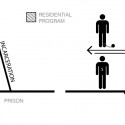With the guidance of there instructor Matthias Hollwich, students Andreas Tjeldflaat and Greg Knobloch from University of Pennsylvania’s School of Design have proposed an alternative to the traditional prisons seen throughout the United States. The innovative high-rise penitentiary acknowledges the fact that nearly two-thirds of the 14,000 inmates released annually from New Jersey correctional facilities will return to prison within five years. 499.SUMMIT offers a solution that intends to reverse that statistic and help inmates successfully transition back into society.
Continue after the break for more.
Click here to view the embedded video.
Project Description provided by Andreas Tjeldflaat and Greg Knobloch:
The US prison system has failed to see advancements throughout the past century and desperately requires innovation and re-imagination. While recent literature begins to question the sociological impact of prisons, there has been little exploration of the physical apparatus in which inmates are housed.
499.SUMMIT is the outcome of a critical look into these static institutions. It proposed to challenges all preconceived notions of the word “prison”, and re-imagines the high-rise as an urban penitentiary. The massing consists of three towers in the shape of an arch. The inherent linear and formal qualities of the ‘arch’ allowed for the overall circulatory concept: Up, over, down. Each arch has three primary phases, Incarceration (up), Transformation (over), and Integration (down). The arches begin isolated during the incarceration phase and merge together both physically and programmatically during the integration phase. As the inmates graduate through the facility, they are being exposed to an increasing degree of social interaction, to make the transition back into society as soft as possible. To catalyst this process, public program and residential housing are introduced in the integration phase downwards.






















499.SUMMIT Reimagines U.S. Prisons originally appeared on ArchDaily, the most visited architecture website on 13 Apr 2012.
send to Twitter | Share on Facebook | What do you think about this?






